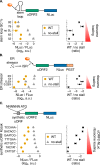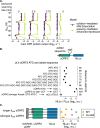Translational buffering by ribosome stalling in upstream open reading frames
- PMID: 36315596
- PMCID: PMC9648851
- DOI: 10.1371/journal.pgen.1010460
Translational buffering by ribosome stalling in upstream open reading frames
Abstract
Upstream open reading frames (uORFs) are present in over half of all human mRNAs. uORFs can potently regulate the translation of downstream open reading frames through several mechanisms: siphoning away scanning ribosomes, regulating re-initiation, and allowing interactions between scanning and elongating ribosomes. However, the consequences of these different mechanisms for the regulation of protein expression remain incompletely understood. Here, we performed systematic measurements on the uORF-containing 5' UTR of the cytomegaloviral UL4 mRNA to test alternative models of uORF-mediated regulation in human cells. We find that a terminal diproline-dependent elongating ribosome stall in the UL4 uORF prevents decreases in main ORF protein expression when ribosome loading onto the mRNA is reduced. This uORF-mediated buffering is insensitive to the location of the ribosome stall along the uORF. Computational kinetic modeling based on our measurements suggests that scanning ribosomes dissociate rather than queue when they collide with stalled elongating ribosomes within the UL4 uORF. We identify several human uORFs that repress main ORF protein expression via a similar terminal diproline motif. We propose that ribosome stalls in uORFs provide a general mechanism for buffering against reductions in main ORF translation during stress and developmental transitions.
Copyright: © 2022 Bottorff et al. This is an open access article distributed under the terms of the Creative Commons Attribution License, which permits unrestricted use, distribution, and reproduction in any medium, provided the original author and source are credited.
Conflict of interest statement
The authors have declared that no competing interests exist.
Figures







Similar articles
-
uORF-Tools-Workflow for the determination of translation-regulatory upstream open reading frames.PLoS One. 2019 Sep 12;14(9):e0222459. doi: 10.1371/journal.pone.0222459. eCollection 2019. PLoS One. 2019. PMID: 31513641 Free PMC article.
-
Impacts of uORF codon identity and position on translation regulation.Nucleic Acids Res. 2019 Sep 26;47(17):9358-9367. doi: 10.1093/nar/gkz681. Nucleic Acids Res. 2019. PMID: 31392980 Free PMC article.
-
Translation of TNFAIP2 is tightly controlled by upstream open reading frames.Cell Mol Life Sci. 2020 May;77(10):2017-2027. doi: 10.1007/s00018-019-03265-4. Epub 2019 Aug 7. Cell Mol Life Sci. 2020. PMID: 31392347 Free PMC article.
-
Regulation of fungal gene expression via short open reading frames in the mRNA 5'untranslated region.Mol Microbiol. 2003 Aug;49(4):859-67. doi: 10.1046/j.1365-2958.2003.03622.x. Mol Microbiol. 2003. PMID: 12890013 Review.
-
Conserved Upstream Open Reading Frame Nascent Peptides That Control Translation.Annu Rev Genet. 2020 Nov 23;54:237-264. doi: 10.1146/annurev-genet-112618-043822. Epub 2020 Sep 1. Annu Rev Genet. 2020. PMID: 32870728 Free PMC article. Review.
Cited by
-
Translational efficiency in gas-fermenting bacteria: Adding a new layer of regulation to gene expression in acetogens.iScience. 2023 Nov 2;26(12):108383. doi: 10.1016/j.isci.2023.108383. eCollection 2023 Dec 15. iScience. 2023. PMID: 38034355 Free PMC article. Review.
-
Upstream open reading frames: new players in the landscape of cancer gene regulation.NAR Cancer. 2024 May 20;6(2):zcae023. doi: 10.1093/narcan/zcae023. eCollection 2024 Jun. NAR Cancer. 2024. PMID: 38774471 Free PMC article. Review.
-
Massively parallel identification of sequence motifs triggering ribosome-associated mRNA quality control.Nucleic Acids Res. 2024 Jul 8;52(12):7171-7187. doi: 10.1093/nar/gkae285. Nucleic Acids Res. 2024. PMID: 38647082 Free PMC article.
-
Unlocking the potential of RNA-based therapeutics in the lung: current status and future directions.Front Genet. 2023 Nov 23;14:1281538. doi: 10.3389/fgene.2023.1281538. eCollection 2023. Front Genet. 2023. PMID: 38075698 Free PMC article. Review.
-
Translational buffering tunes gene expression in mouse and human.bioRxiv [Preprint]. 2025 May 21:2025.05.16.654561. doi: 10.1101/2025.05.16.654561. bioRxiv. 2025. PMID: 40475396 Free PMC article. Preprint.
References
-
- Johnstone TG, Bazzini AA, Giraldez AJ. Upstream ORFs are prevalent translational repressors in vertebrates. The EMBO Journal [Internet]. 2016. Apr 1 [cited 2020 Nov 20];35(7):706–23. Available from: https://www.embopress.org/doi/full/10.15252/embj.201592759 - DOI - PMC - PubMed
Publication types
MeSH terms
Substances
Grants and funding
LinkOut - more resources
Full Text Sources

